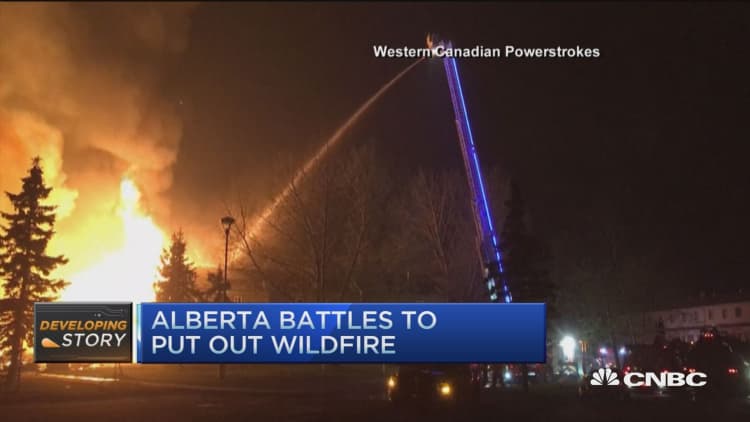
As hundreds of firefighters and some two dozen air tankers battle Canada's massive wildfires, scientists and other experts say prolonged modern droughts and climate change are creating a new perfect storm of super fires and other extreme weather events.
"Based on what we know and in which direction the climate is going, yes, we can expect more frequent super fires," said Marko Princevac, a fire expert at the University of California at Riverside. "There is scientific consensus that climate change will lead to much more intense fires, more dry areas."
The Canada fire began May 1, and has forced more than 88,000 people to evacuate. It could burn for months before the blaze is under control.
Several Canadian communities are under mandatory evacuation orders, according to Alberta officials, including Fort McMurray — an oil sands boomtown. Located primarily in Alberta, Canada, and regions of Venezuela, valuable crude oil is extracted and processed from oil sands.
The current fire situation, as of an update late Monday, includes:
- A total of 29 wildfires are currently burning.
- Fort McMurray wildfire is about 204,000 hectares — more than 787 square miles, an area larger than Oklahoma City — and was anticipated to grow by Tuesday.
- The wildfire is approximately 25 to 30 kilometers from the Saskatchewan boundary.
- There are 1,547 firefighters, 121 helicopters, 194 pieces of heavy equipment and 28 air tankers fighting the fires.
Several conditions are colliding to make the McMurray fire extremely difficult for firefighters.
Perfect storm of fire conditions
For starters, Fort McMurray features complex, hilly terrain, where the fire can spread much faster than on flat land. The reason lies in basic physics. Heat such as the sun striking a hill generates its own air known as "upslope flow" that travels to higher terrain.
In the case of a fire, the blaze replaces the sun as a heat source, and the fire in essence produces its own "upslope flow" that's proportional to the fire's strength. "So now the fire is creating its own wind that helps it propagate," says Princevac.
Trained in mechanical engineering that's about heat transfer and combustion, Princevac began studying fires in the wild about a decade ago. Wildfires, in essence, are another application of combustion.
The McMurray fire is a crown fire in which the blaze spreads from treetop to treetop. And crown fires are much more intense and spread faster than surface-level blazes.
The Canada fire also is being fanned by dry soil conditions. The last substantial monthly rainfall for Fort McMurray was in July, according to Environment Canada and the Citizen Weather Observer Program.
In the U.S., temperatures continue to set new records as the fire season in many parts of the country has now stretched to as many as 300 days of the year.
During the first third of the year, from January through April, the average temperature for the contiguous United States was 4 degrees Fahrenheit above the 20th-century average, making this period the second warmest on record, according to the National Oceanic and Atmospheric Administration.
Meanwhile, climate change has already led to U.S. fire seasons that are now on average 78 days longer than in 1970, according to a report on the rising cost of wildfire operations from the U.S. government last year.
More wildfire risks
The six worst fire seasons since 1960 have all occurred since 2000, according to the U.S. report. Since 2000, many Western states have experienced the largest wildfires in their state's history.
And literally adding fuel to the fire, more development has been taking place near U.S. forests over the years.
The naturally occurring weather trend known as El Nino also is happening amid climate change.
That means El Nino's impacts could be less predictable and more severe, according to Stephen O'Brien, U.N. under-secretary-general for the coordination of humanitarian affairs. He made the prepared remarks earlier this year.
O'Brien said in some global regions, millions of people are already facing food insecurity caused by droughts related to El Nino. Some regions also face potentially devastating effects on the agricultural sector, including floods, landslides and droughts, possibly leading to forest fires, according to the U.N.




